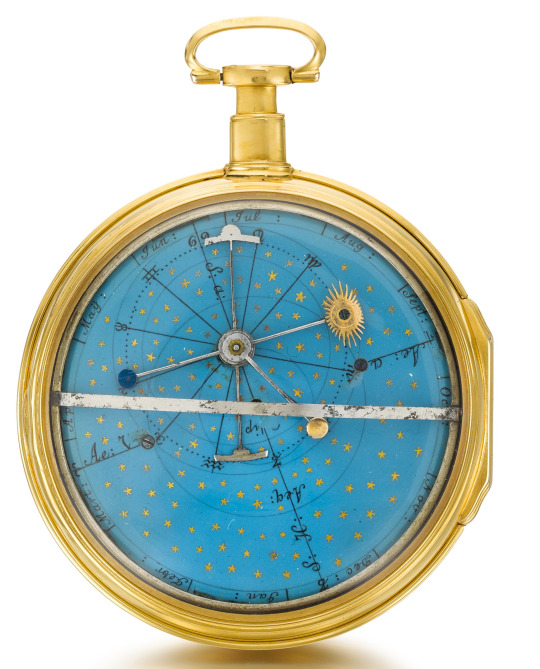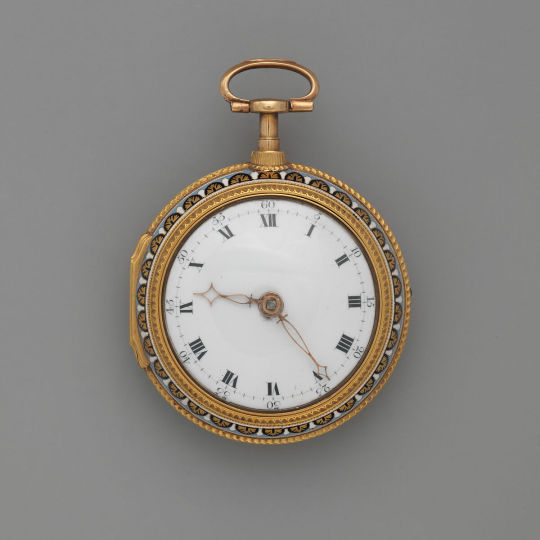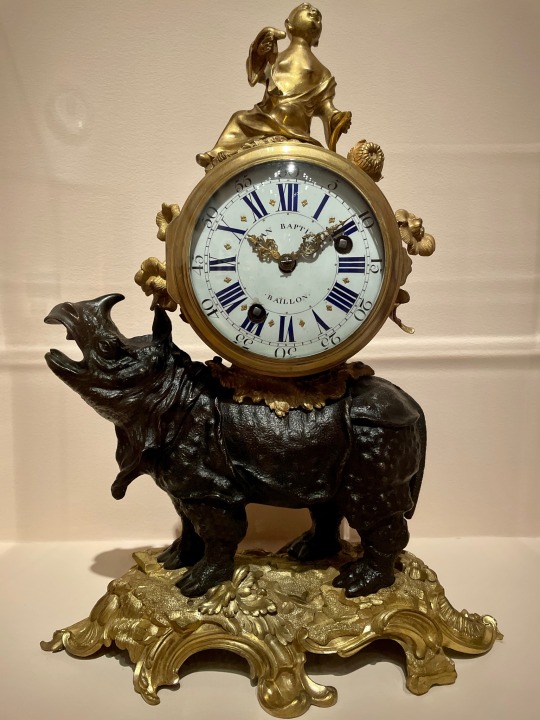#18th century clock
Text


Gold Double Dialed Astronomical Calendar Watch with Geocentric (having or representing the earth as the center of the universe) Planetarium, C. 1790.
Movement: gilded full plate with going barrel, cylinder escapement, plain three-arm balance• Dials: first: white enamel, the edge with Arabic numerals for hours running twice from 1-12 in black and 1-12 in pink, four subsidiary dials for minutes, date combined with month, regulation, seconds combined with days of the week, aperture for winding, gold hands, the hour hand with an additional steel support carrying a square for rapid resetting of the calendar • second: light blue enamel geocentric planetarium dial decorated with gold stars and an outer month ring, various lines of the ecliptic zodiac marked in black, with three concentric hands of steel mounted with the earth, a gold sun and moon, the entire dial revolving once per year, the ecliptic line shown by a polished steel band attached to the engraved silver dust ring• Case: plain gold moulded bezels.
1K notes
·
View notes
Text

A watch from watchmaker John Holmes, 1797-98
21 notes
·
View notes
Text
It’s Clara! (probably) 🦏



Jean-Baptiste Baillon, clockmaker (French, d. ca. 1770)
Attributed to Jean-Joseph de Saint-Germain,
bronze maker (French, 1719-1791)
Mantel Clock, after 1749
Virginia Museum of Fine Arts display
“This mantel clock exemplifies the exuberant Rococo style of the mid-18th century that delighted in the apparent novelty and exoticism of Asian cultures as they were perceived in the popular European imagination.
Ménagerie clocks featuring models of unfamiliar beasts from Africa and Asia became highly fashionable collectibles in the 1740s. Though the rhinoceros was known in Europe as early as the 16th century, it was not until a live Indian rhinoceros named Clara was brought to the Netherlands in 1741 that the animal became a widely recognized marvel. Clara was exhibited throughout Europe for nineteen years, delighting average citizens and courtiers alike. In 1749, she arrived in Paris, where she inspired drawings by many artists and studies by scientists. The model for this clock was likely based on one of these renderings.”
#animals in art#european art#museum visit#rhino#rhinoceros#Indian rhinoceros#French art#18th century art#clock#bronze#sculpture#decorative arts#metalwork#Clara the Rhinoceros#VMFA#Virginia Museum of Fine Arts
29 notes
·
View notes
Link
The monarch, 73, entrusted the team with two antiques in August 2021
Charles waited patiently for six months as experts restored a piece of pottery made for Queen Victoria's Diamond Jubilee and a 18th century clock
King stressed the importance of preserving historical pieces in new trailer
10 notes
·
View notes
Text
saw someone with tattoos evocative of a stocking line down the back of the calf, and suddenly I NEED a tattoo based on an C18th clocking design................ suggestions in replies I guess zbjfjeks all other tattoo plans are officially on hold until this happens
#tattoos#pointless post is pointless#18th century fashion#historical fashion#historical stockings#clocked stockings#actually tagging this because I'm only half joking about the suggestions pls#I'll look some up when i get home but. !!
3 notes
·
View notes
Text
its art school i have no idea what the standards for my essay are
#this is a very insightful essay however i wish you had focused more on the piece so i#had to dock 3 points#LIKE i feel like im not talking about the PIECE itself enoug#but the piece is kind of less a work of passion by an artist and more a symptom of the fetshization of chinese culture by Europe during the#18th century the piece was MADE for profit and its exist solely relies on the popularization of chinoiserie#so like i can mention the little scenes painted on the clock and the shallow cultural gesturing the peice is doing to be#identifiable as the culture its trying to portray#but its hard to talk about the piece individually because aside referencing the structure and the scenes theres not much else to talk about#but theres a LOT historically i could talk about but i know the focus is supposed ot be the PIECE#but the PIECE has so much history behind it#I JUST dont want feedback from the TA being like or smthing#12/15.... scary
2 notes
·
View notes
Link
Decorative Items - A very charming, late 18th century Swedish painted Mora clock, hand scrapped to reveal the original warm orange paint with a hint of blue in the moulure, together with the pendulum and weights. Please note that while the clocks are complete we do not guarantee the functionality of them.
0 notes
Text





The largest sundial in the entire ancient world: The “Horologium Augusti” or Augustus Sundial, built in the year 10 BC, commissioned by the emperor himself to the architect Facundus Novius.
Solar Clock was built on a large circular square of travertine marble that occupied about 160 m by 75 m and was located on the Campus Martius, between the Mausoleum of Augustus and the Ara Pacis. The gnomon (the element that casts the shadow) was nothing more than a 30 m high red granite obelisk, brought from Heliopolis (Egypt) and which had been erected by Pharaoh Psammetik II between 595 and 589 BC.
It was crowned by a bronze orb or globe and projected its shadow, depending on the position of the sun, on a quadrant with lines and letters of inlaid gilded bronze, which indicated the months and seasons.
It was placed in such a way that the shadow fell on the center of the Ara Pacis on September 23, the birthday of Augustus himself.
The obelisk of the Augustus Sundial stood between the 8th and 12th centuries, when it was broken and practically buried and forgotten. Rediscovered at the end of the 18th century (1748) it was restored and re-erected by Pius VI (1792). Today we can admire it in Piazza de Montecitorio, in front of the current headquarters of the Italian Parliament.
310 notes
·
View notes
Text
Beings are sorted from oldest to youngest.
#196#my thougts#worldbuilding#fantasy#urban fantasy#my worldbuilding#monster lover#fae#faries#dark fantasy#farie#fair folk#fae folk#folklore
186 notes
·
View notes
Text

The dance of death. Oil painting.
The Dance of death originates in mediaeval plays and folk rituals performed on the Feast of the Holy Innocents (28 December), and in funeral sermons. In the most popular version, Death (in the form of a skeleton) dances in succession with people representing particular social ranks (Pope, emperor, king, lawyer, peasant, etc.) and takes away each in turn, demonstrating that nobody however exalted in this life, can escape death. Conversely, nobody, however humble in this life, is in the end worse off than the rich and mighty. The theme lent itself to long mural paintings in which the entire sequence is depicted: examples (now destroyed) were the walls of the cemetery of the Holy Innocents in Paris, 1425, or the of the Predigerkirche in Basel, ca. 1440. It could also be painted in the bays within a cloister, where the monks and pilgrims would pass each scene in turn as they walked around the cloister (as in Old St Paul's Cathedral, London)
In 1485, when printed books were still a novelty, the Dance of Death was first published as a series of woodcuts (to be succeeded later by engravings), in which each individual scene occupied a separate page of a book. The vivid woodcuts of this subject by Hans Holbein (1538) were studied throughout Europe. As a result most people viewing the Dance of Death would be using media in which they could only see the episodes one at a time
In the seventeenth century, painters and print makers created versions of the Dance of Death which represented all the episodes in one painting or engraving, often together with other motifs such as skulls and clocks added to reinforce the message. In Germany, five such engravings are known from the 17th and 18th centuries, and many paintings with the same general composition are known from churches in Poland, Croatia, Germany, Slovakia and elsewhere. The paintings and prints have many variations from each other, which may eventually permit their origins to be known through a family tree of earlier versions and copies. Many of them were commissioned by the order of Observant Franciscans (Order of Friars Minor) for the sacristies or waiting rooms of their churches. The present painting in the Wellcome Library is one these, and another, larger version is in the Church of Saint Bernardino of Siena in Kraków
Wellcome Collection
46 notes
·
View notes
Text
Americans [...] would sip the rich cocoa as a hot drink. Cocoa made its way to North America on the same ships that transported rum and sugar from the Caribbean and South America [...] and was heavily reliant on the labor of enslaved Africans throughout the diaspora. [...] [B]y the early 1700s, Boston, Newport, New York and Philadelphia were processing cocoa into chocolate to export and to sell domestically. Chocolate was popular in the coffeehouse culture and was processed for sale and consumption by enslaved laborers in the North. Farther south, in Virginia, cocoa was becoming [...] so popular that it is estimated that approximately one-third of Virginia’s elite was consuming cocoa in some form or another. For the wealthy, this treat was sipped multiple times a week; for others it was out of reach. [...]
The art of chocolate-making – roasting beans, grinding pods onto a stone over a small flame – was a labor-intensive task. An enslaved cook would have had to roast the cocoa beans on the open hearth, shell them by hand, grind the nibs on a heated chocolate stone, and then scrape the raw cocoa, add milk or water, cinnamon, nutmeg or vanilla, and serve it piping hot.
---
One of the first chocolatiers in the Colonies was an enslaved cook named Caesar.
Born in 1732, Caesar was the chef at Stratford Hall, the home of the Lees of Virginia, and in his kitchen sat one of only three chocolate stones in the Colony. The other two were located at the governor’s palace and at the Carter family estate, belonging to one of the wealthiest families in Virginia. Caesar was responsible for cooking multiple meals a day for the Lees and any free person who came to visit. [...]
---
The work was oppressive in the plantation kitchens at Christmas time. [...]
[T]hose working in the big house kitchen and as domestic laborers were expected to work around the clock to ensure a perfect holiday for the white family. The biggest task at hand was to cook and serve Christmas dinner, and chocolate was a favorite addition to the three-course formal dinner. [...] Oyster stew, meat pies, roasted pheasant, puddings, roasted suckling pig and Virginia ham are some of the many dishes that would be served in just one course. The night would finish with the sipping of chocolate: toasted, ground and spiced [...] and served in sipping-cups made specifically for drinking chocolate. [...]
---
Decades before the two well-known enslaved chefs, Monticello’s James Hemings and George Washington’s Chef Hercules, [...] Caesar was running one of the Colonies’ most prestigious kitchens inside of Stratford Hall, and making chocolate for the Lees and their guests. [...] [H]is son, Caesar Jr., lived nearby and was the postillion [...].
The stress of cooking the most important dinner of the year was combined with the fear of what was to come on Jan. 1. New Year’s Day was commonly known as heartbreak day, when enslaved folks would be sold to pay off debts or rented out to a different plantation. Jan. 1 represented an impending doom, and the separation of families and loved ones. [...] Caesar disappeared from the records by the end of the 18th century. By 1800, his son Caesar Jr. was still owned by the Lees, but as that year ended, Christmas came and went, and Caesar Jr. was put up for collateral by Henry Lee for payment of his debts.
---
The world Caesar lived in was one fueled by the Columbian Exchange, which was built from enslaved labor [...]: pineapples, Madeira wine, port, champagne, coffee, sugar and cocoa beans. These items traveled from plantation to dining room via the Atlantic trade, and were central to securing the reputation of Virginia’s plantation elite. The more exotic and delicious the food, the more domestic fame one would reap. Having cocoa delivered directly to your home, and having a chocolatier in the kitchen, were exceptional. It was through Caesar’s culinary arts that Stratford Hall became well-known throughout Colonial Virginia as a culinary destination.
---
All text above by: Kelley Fanto Deetz. “Oppression in the kitchen, delight in the dining room: The story of Caesar, an enslaved chef and chocolatier in Colonial Virginia.” The Conversation. 21 December 2020. [Bold emphasis and some paragraph breaks/contractions added by me.]
346 notes
·
View notes
Text
Here’s the thing that bugs me about Ricky’s clock plan.
Even if you ignore the fact that Zheng and Auntie should have been suspicious and a gift of a clock being bad luck in Chinese culture, there’s another reason the plan would have never worked.
Clocks didn’t work on ships in the early 18th century. The problem was that they kept time with the swinging of a pendulum and the movement of the water would throw off the clock as a result. It could be running fast, or it could be slow. Even the slightest amount of movement in the water can cause it to be thrown out of sync.
That means that at least one of the clocks would have been running ahead of some of the others. We wouldn’t have had that gorgeous almost simultaneous explosion and it’s likely at least one ship could have been spared in the delay between the first and last clocks.
In fact it was so well known that clocks didn’t work properly that some ports fired guns to mark each hour so the sailors could reset their clocks to the right time. It was important that they knew what the time was so they didn’t get lost, it wasn’t until the late 18th century that a clock was invented that didn’t rely on the pendulum so it could be used at sea.
This post is thanks to Mario at the time gun museum in Malta. He gave us a talk on the subject which has become surprisingly useful and I’m astounded by how much I’ve actually retained
#ofmd#our flag means death#ofmd stede#ed ofmd#blackbeard#blackbonnet#ofmd edward teach#gentlebeard#blackbeard ofmd#ofmd meta#ofmd s2#ofmd season 2#ofmd 2#ofmd spoilers
133 notes
·
View notes
Text
nation sightings in urban areas: “My grandma ran into Mr. America at the MET fifty years ago! He was staring at this old painting and she asked if it reminded him of an older world, he told her that every step taken creates a new world out of the old. They’re a very deep and strange species.
nation sightings in rural areas: I found Alfred passed out in my uncles barnyard last week cradling a power drill, an empty bag of soil, and a genuine 18th century cuckoo clock. I had to chase him out with a broom. Third time this month.
#Hetalia#aph america#hws america#alfred f jones#don’t humans canonical know about nations but just think they’re really fuckin weird?
801 notes
·
View notes
Text
a lot of places just want you to have A Degree which the claim is that it proves you have the ability to pick something + stick to it + stay on top of assignments and manage your time etc (tags left on this post about academia as a class barrier, via @seveneyesoup)
this is putting me in mind of the idea of the "accomplished" gentlewoman in 18th & 19th-century England: how a woman, to be worthy of installment in a heterosexual marriage as the mistress of a home, manager of servants, refuge for her husband (depending on the source of his money) from the harsh world of capital, & instiller of virtue in children, must herself demonstrate virtue and aptitude for certain tasks by collecting a train of accomplishments well before the time when she is no longer of marriagable age (say, mid-to-late twenties).
sometimes there is a direct link posited between the accomplishments she is meant to be obtaining and her ability to make a man a good wife (playing at the pianoforte means she may amuse him); sometimes the link is a bit less direct (maybe he'll like being surrounded by prettily designed tables and painted screens? given the Victorian moralisation of aesthetics & domestic decoration that could make sense); sometimes the reasoning is a bit circular (she may teach her daughters feminine accomplishments and thus enable them to make good wives); sometimes it's hypothesised that the point of all of this is to demonstrate genteel idleness ("look how much time I have to do things that are neither earning money nor immediately necessary to the running of the household").
but, though certain accomplishments were considered necessary for decades together (European languages, pianoforte playing or perhaps the harp, dancing), others (designing tables, netting purses, painting screens) went in and out of fashion, or even through what you might call fads. I remember reading one man in particular complain about how ugly Berlin wirework (a type of needlepoint / embroidery done on a wire frame) was, and how he hoped women would soon tire of it.
so sometimes the point of gaining an accomplishment when it may be considered very dated by the time you have daughters of an age to be taught anything is considered to be demonstrating an aptitude for things-doing, in general. shewing that you are patient, dedicated, quiet, good at managing time and exacting self-discipline, content to stay at home, capable of applying sustained concentration and physical effort to a task (that does not produce money and that, if it is 'fancy' work, may not produce anything necessary at all)...
these are the qualities, supposedly, that enable a woman to do the administrative & planning tasks required to run a household, emotionally support and/or submit to her husband, &c. 'moral' discipline is also necessary to the maintenance of the family as the unit of social reproduction along the lines of inheritance (that is, you want to marry a virginal woman to ensure that your children are 'yours').
& of course this is all economic—making oneself erotically desirable to a man of the appropriate class is the only way to preserve or advance one's rank / class status if one is not independently wealthy (or possessing of a sibling or something willing to support you).
this sort of pre-conditioning reminds me of the amount of social / military &c. disciplining that is required for a proper 'workforce' to be created (proletarianisation); a population must be broken of habits including a tendency to rest—to do things at unpredictable or inconvenient (for the owning class) times—to consult an almanac rather than a clock in deciding whether and when to go to work—or to fuck off for a while with no notice to go do seasonal work—if they are to be a viable source of factory labour.
so the idea of pre-disciplining—of a certain attitude towards time, labour, the self, and society being inculcated in people in order to suit them for a specific type of labour—as well as the idea of 'self-discipline' being a sort of muscle that disciplining the self can train, and whose strength can then be put to performing other tasks than the ones that first exercised it—is a common thread that runs through these different situations.
I think a full analysis of this would also have to explore the tension between the above 'self-discipline' and the mythicisation of the idleness of the Victorian bourgeois housewife (even as many of them really did perform many tasks around the home), as well as the tension between the supposed Very Extra Importance and Busy-ness and the actual lack of a time-discipline of the sorts of sinecures that having the right university degrees + knowing the right people can get you.
#this also leaves out a lot of other kinds of labour including forced labour#but I'm not trying to be exhaustive here#long post /#women's labour#Victorian
111 notes
·
View notes
Text
Okay, I don't remember the exact episode, but at one point the Night Nurse said she's spent, "Over two million hours on the job". And I did some math about that.
I'm working from the assumption that if the Night Nurse had spent three million or more hours on the job she'd have said, "Over three million hours on the job," so she's worked for fewer than three million hours and I have a hard upper limit.
She seems like the kind of person to spend as much time on the clock as possible, which for her is all of it. If she works 24/7, she has been on the job for somewhere between 228.31 and 342.47 years.
If she works a more reasonable 40-hour week , she has been on the job for somewhere between 961.54 and 1442.31 years.
Her first day on the job would have been in, respectively, 1796, 1681, 1062, or 582. (I'm using 2024.33 for the current year because the show was released at the end of April.)
Either way, she is incredibly young for an "eternal, transdimensional being", for someone who works for the Afterlife as some sort of quasi-demon/angel thing with supernatural powers. The most generous estimate of her age makes her first day after the Fall of Rome and King Arthur. More likely estimates make her first day somewhere towards the end of the 17th or in the 18th century -- it's possible she's younger than the US.
Was she a human who was granted supernatural powers in exchange for doing a job? Was she only created a few hundred years ago? What's her deal? Why is she so young (comparatively)?
I'm prepared to accept that time works differently in the Afterlife. But one of the people working for her said they'd been looking for the Devlin girls for 29 years, which is concurrent with the time they'd spent trapped in the loop so it seems like time works the same way in the Afterlife and on the mortal plane.
Whatever the case, the Night Nurse does not have nearly enough experience to have as much power or authority as she thinks she does.
27 notes
·
View notes
Text
Haze
Hazing was the practice of making the crew work around the clock, whether it was necessary or not, to deprive them of sleep and make them generally unhappy. Until the middle of the 18th century, this was thought to prevent mutinies and desertion, but in the end the opposite happened and multiple shifts of watch duty and free time were guaranteed. In the 19th century, many captains used this practice again to assert their authority as the crews on the ships became smaller and smaller. As a result, many no longer wanted to serve on ships and extra incentives such as extra money had to be offered.
#naval history#haze#work aboard a ship#naval term#18th century#19th century#age of sail#age of steam
58 notes
·
View notes